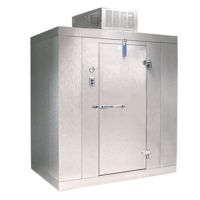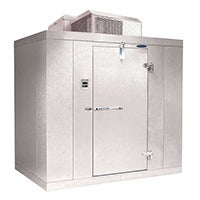Walk-In Refrigeration
Walk-In Refrigerators
Store perishable goods safely and efficiently. Your walk-in is one of the most important pieces of equipment in any foodservice operation. Featuring durable construction, lots of storage space, and customizable options, these units are perfect for any business.
Walk-In Freezers
Provide your kitchen with increased storage capacity and versatility to stay stocked with the most popular ingredients. Choose between indoor or outdoor units. Available in a variety of sizes, or custom build your own with Burkett Concepts.
Invest in a walk-in cooler or freezer to expand cold storage in your commercial kitchen.
Many foodservice establishments make use of walk-in coolers and freezers because they provide a large amount of cold storage space. For commercial kitchens, the walk-in is a highly necessary piece of restaurant equipment. As food deliveries come in, staff will need a place to safely store and organize food products. In order to meet food safety standards, food must be stored according to a hierarchy designed to limit opportunities for cross contamination. Keeping raw meats and fish above vegetables and ready-to-eat foods creates a high-risk environment for foodborne illnesses. A walk-in refrigerator or freezer helps organize food properly, since they provide plenty of room for epoxy coated shelving made specifically for refrigerated storage. By dedicating specific shelves and areas to each food item, staff will be able to quickly prep and serve delicious, safe food.
Burkett Restaurant Equipment & Supplies has a variety of Norlake walk-in coolers and Kolpak walk-in coolers to meet the needs of commercial restaurants, cafeterias, and other venues. If you are looking for a custom walk-In refrigeration unit, chat with, email, or call one of our sales professionals.
For more related walk-in refrigeration items, checkout our food pan carrier carts, plastic dunnage racks, and the walk-in cooler / freezer parts & accessories section.
Buying considerations for walk-in coolers and freezers
- Installation - One of the first things you will need to consider when looking for a walk-in cooler is whether it will be used inside or out. Outdoor walk-in coolers will need special coating on the exterior metal to protect it from the elements. The compressor will also need a special cover. Indoor walk-in coolers will be a separate room all to themselves. Regardless of what kind of walk-in freezer you choose, it's sure to be a large undertaking. It's best to have a walk-in installed on slow days, or while still under construction if possible. Walk-in units can come pre-assembled or can be assembled on-site. If the unit does not fit through your door, it will need to be assembled on site.
- Dimensions - Whether installing a walk-in freezer in an existing building, or during the construction phase of a new building, you will want to take into account the overall size of the unit. Remember that each wall has about four inches of insulation, so the interior dimensions will be slightly smaller than the exterior. Take this into account when estimating the storage space, you need.
- Insulation type - Since a walk-in refrigerator or freezer is responsible for cooling a whole room of food products, insulation can be a big factor in energy cost and efficiency. There are a few standard options when it comes to commercial refrigeration insulation:
- Foamed-in-place polyurethane - One of the most popular options for insulation in commercial refrigeration right now. This type of insulation is sprayed directly between metal panels that make up the walls and ceilings of the walk-in unit. It is moisture and fire resistant, with a melting point around 700°F. This powerful insulation will lock cold air in your walk-in unit and is a permanent insulation system.
- Extruded polystyrene (XEPS) - This type of insulation is manufactured by laminating the outer metal exterior onto foam blocks for their insulating properties. While this option is more affordable, it is less effective than other options and panels may delaminate over time.
- Laminated panels - Similar to extruded polystyrene, this type of insulation is achieved by gluing polyurethane slabs to the insides of the walk-in refrigerator's interior panels. Again, this option is affordable but may not hold up over time.
- Flooring - Another consideration to keep in mind when searching for a walk-in cooler is whether you need it to come with a floor or not. Both options have their own unique benefits. Floors that come with walk-in refrigerators are usually grooved or textured metal. Many establishments opt to lay their own tile floors inside the walk-in for a more customized look, or to match the flooring of the rest of their industrial kitchen. Any type of flooring placed in a walk-in refrigerator or freezer will benefit from being insulated. Plus, walk-in freezers run so cold, a standard floor may be prone to cracking if not insulated. Another factor to consider when choosing walk-in refrigerator or freezer flooring is its ability to be easily cleaned. The walk-in can be a messy place. With foot traffic in and out all day long, and food being transported, it's bound to collect debris. Spills happen, and clean up should be quick and easy.
To learn more about choosing your walk-in cooler or freezer, check out our Walk-In Coolers Buyer's Guide.
Frequently Asked Questions About Walk-in Coolers and Freezers
How long will a walk-in cooler or freezer last?
A good estimation on walk-in refrigeration life span is around 15 years. With regular cleaning and maintenance, your walk-in refrigerator or freezer could last even longer.
When should I buy a new walk-in unit?
Outside of its typical lifespan expectations, a walk-in cooler or freezer may need to be replaced if:
- The old cooler is significantly less efficient/not holding proper temperatures anymore.
- You are starting a new location or expanding the business.
- There is noticeable wear on the exterior lamination or separation of panels from insulation.
- Condensation or frost build up increases on the interior. This may be an indicator of a bad seal.
For more information, check out the article How to Know When It’s Time to Replace Your Walk-In Cooler from the Burkett Blog.
What is an R-value?
In commercial refrigeration, the R-value of a refrigerator or freezer indicates the level of insulation efficiency. The larger the R-value number, the more capable the unit is of keeping ambient air outside the cabinet. R-value does decrease over time, so some manufacturers provide a "projected five year R-value" to help you decide whether it's the right fit for your business. Check your walk-in cooler or freezer's spec sheet to determine its R-value.



Login and Registration Form